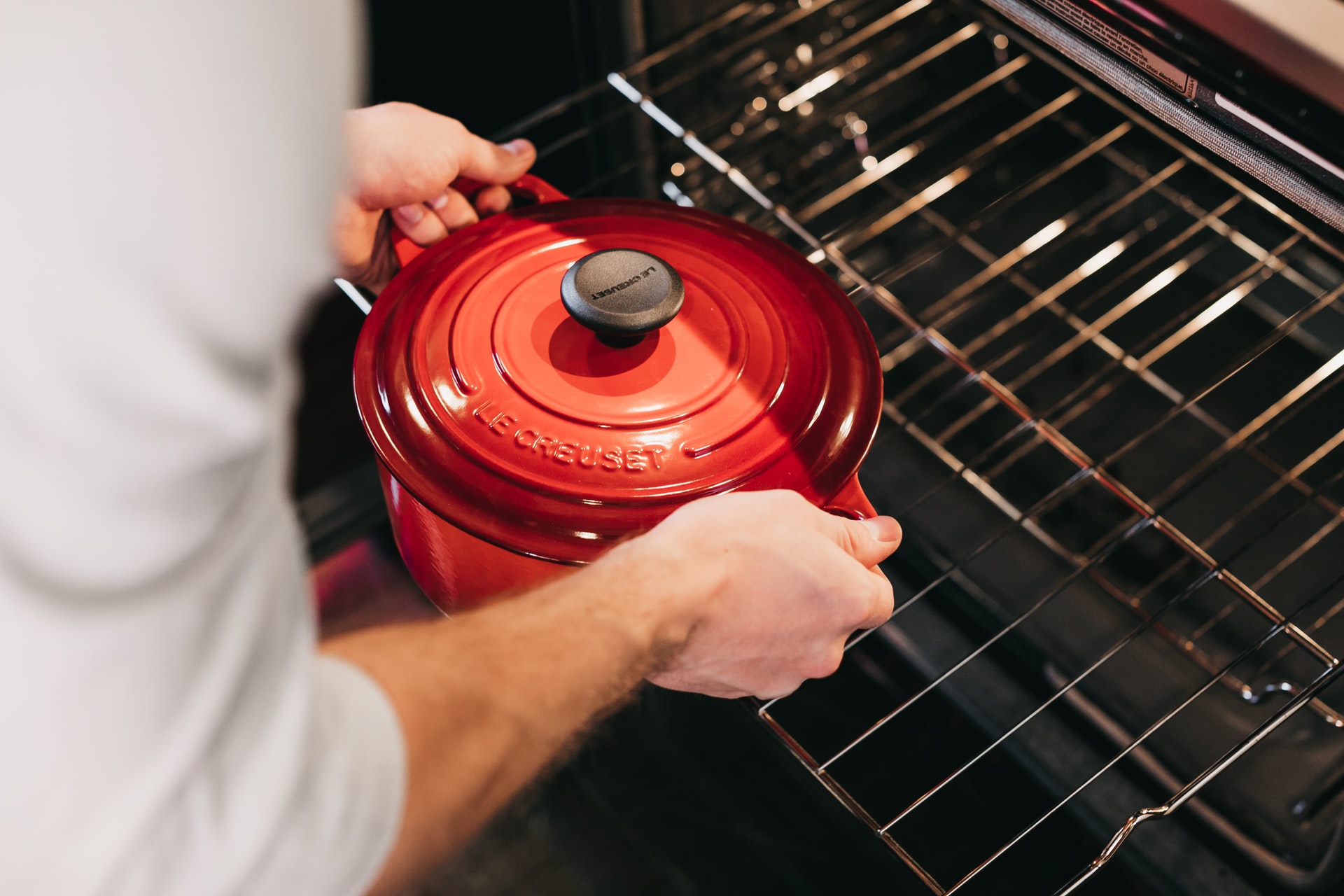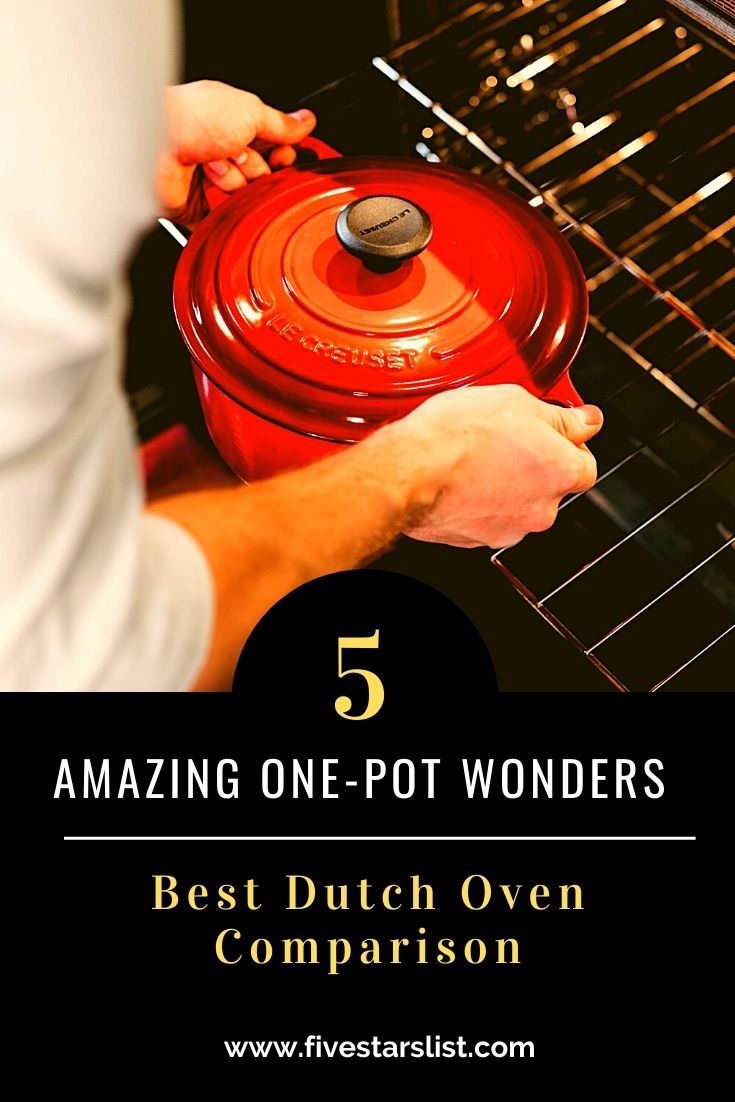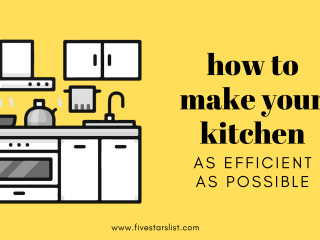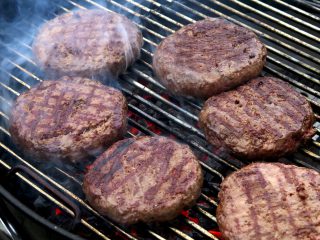As an Amazon Associate I earn from qualifying purchases.

Photo by Becca Tapert on Unsplash
The Dutch oven is a heavy piece of cookware, usually made of cast iron, enameled or not, that was originally designed in a way to absorb the heat from the fire and radiate it evenly to cook food. The main benefit is that it keeps the food moisturized during the long, slow cooking time.
Dutch ovens are some of the oldest ways to prepare the food – they are in use for centuries. Also, they are often called French ovens, but there is really no big difference between these terms. French and Dutch ovens are almost the same. In fact, there is a whole bunch of similar pieces of cookware around the world, called differently. For more information about this, and about Dutch ovens in general, check out this article on Wikipedia.
So, what makes a Dutch oven popular piece of cookware?
It’s the healthiest and most economically sustainable way of preparing the food. The specific low-heat cooking makes the food juicier and tastier than when the food is prepared in other ways. Dutch oven heats evenly, no hotspots, no cold centers, and no burning. The cleaning and seasoning of Dutch ovens are so easy, you just need to carefully follow the instructions. Also, the fact that food has been prepared this way for centuries, gives it some traditional and nostalgic charm.
It would be ridiculous and naïve to expect that absolutely incomparable ovens when we talk about the price, have the same quality. That’s why we’ve decided to divide this article into two parts – budget-friendly Dutch ovens, and, let’s say, “premium” ones.
Best Budget-Friendly Dutch Ovens
Although we’re going to list some of the most affordable Dutch ovens, since we are talking about cookware, and that the food that cooks in it must be delicious, we’ll still have in mind the quality, functionality, and durability.
1. Lodge Enameled Dutch Oven
 This is one of the most popular Dutch ovens on the market. It’s definitely a best-seller. The Lodge family started producing Dutch ovens back in 1896, and they still do it. As advertised, it’s completely made in the USA and that makes it so popular among the American population. But that’s not the only reason why Lodge Dutch ovens are part of every serious list of the best Dutch ovens – they are on the market for over a century and for a reason – they make great products.
This is one of the most popular Dutch ovens on the market. It’s definitely a best-seller. The Lodge family started producing Dutch ovens back in 1896, and they still do it. As advertised, it’s completely made in the USA and that makes it so popular among the American population. But that’s not the only reason why Lodge Dutch ovens are part of every serious list of the best Dutch ovens – they are on the market for over a century and for a reason – they make great products.
It’s made of enameled cast iron, which means that if you season it properly you don’t even need to do anything else before use. You must have in mind that enamel is very easy to chip so you need to be extra careful when handling it. That means, no metal utensils, no soaking in water for a long period, and never straight to high heat. The rims are enameled, too, which is a big plus for a Lodge Dutch oven.
Although it’s dishwasher safe, it’s recommended to use dish soap with a rubber, only. And honestly, you won’t need anything else. Add water for about 10 minutes, then pour in the dish soap, use rubber and dry it immediately. Let it sit for an hour without a lid, put the lid on, and you’re done.
It can be used on the stovetop or in the oven, but keep in mind you need to use lower heat, since, once it comes up to temperature, it stays hot. It’s oven-safe up to 500 Fahrenheit.
Overall, this is a great product for a price; great sized and durable, as long as seasoned properly. If you are budget-oriented, this is the perfect Dutch oven for you.
Check Price2. Round Enameled Cast Iron Dutch Oven by Crock Pot
 This Dutch oven has a convenient and classic design and looks beautiful in any kitchen, but besides that, it’s really a high-quality multifunctional product. You can use it for a variety of purposes: cooking, broiling, baking, roasting, and it’s compatible with, electric stovetops, as well as with pretty much any other. It’s oven-safe up to 450 Fahrenheit.
This Dutch oven has a convenient and classic design and looks beautiful in any kitchen, but besides that, it’s really a high-quality multifunctional product. You can use it for a variety of purposes: cooking, broiling, baking, roasting, and it’s compatible with, electric stovetops, as well as with pretty much any other. It’s oven-safe up to 450 Fahrenheit.
Although enameled, you should never heat it dry. To keep the enamel from cracking and chipping put at least some oil in the pot and spread it around using a brush. Also, make sure not to bang metal spoons on the side of the pot and don’t use metal utensils. All these steps should keep your Dutch oven in good shape.
Cleanup is also an easy process – put some water to boil, turn off the heat, and cover until it’s cool to touch.
The only consideration we could think of is that is a bit heavy, but the weight determines the amount of thermal energy the Dutch oven will hold, so it’s something you have to get used to.
You can’t go wrong with this Dutch oven, so, yes, we do recommend it.
Check Price3. AmazonBasics Enameled Cast Iron Covered Dutch Oven
 AmazonBasics products have a reputation of durable yet affordable and useful items in everyday life. The same goes for this Dutch oven. It won’t cost you a small fortune nor will you be able to brag about your fancy French – branded Dutch oven, but you’ll get a huge high-quality pot for cooking, boiling, baking, frying, etc. It is advertised as safe for all cooking surfaces, and oven safe up to 400 Fahrenheit degrees.
AmazonBasics products have a reputation of durable yet affordable and useful items in everyday life. The same goes for this Dutch oven. It won’t cost you a small fortune nor will you be able to brag about your fancy French – branded Dutch oven, but you’ll get a huge high-quality pot for cooking, boiling, baking, frying, etc. It is advertised as safe for all cooking surfaces, and oven safe up to 400 Fahrenheit degrees.
This is the most decent Dutch oven for the money. It’s large, a very solid piece with thick and even enamel coating, and a boy, it’s heavy, which is good, indeed.
It’s not dishwasher – safe, but even if it was, it’s always recommended to clean Dutch ovens manually, in the way we described in this article. Also, you must keep in mind that, although enameled, this Dutch oven is not a non-stick, so the proper care is a key for a long life of this Dutch oven. Also, if you experience black marks on the enamel use baking soda to clean it, so, no aggressive abrasives.
Overall, it’s a great product and if you decide to purchase this Dutch oven, you surely won’t be disappointed.
Check PriceWhen it comes to „premium“ Dutch ovens, we don’t have too many options to choose between. There are two really big players in this field – Le Creuset and Staub. These eternal rivals provide us equal results in a way that the real winner of this game seems to depend on your personal choice.
Anyway, we’ll take a deeper look into these pricey Dutch ovens. We’ll see what makes them so different from lower-priced ovens, check the differences between them, and see if they are really worth the money.
1. Staub Cast Iron Round Cocotte
 Don’t let the word “Cocotte” in the name of the product confuse you. It’s just a French word and means “casserole” but Americans call it simply a Dutch oven.
Don’t let the word “Cocotte” in the name of the product confuse you. It’s just a French word and means “casserole” but Americans call it simply a Dutch oven.
Staub’s Dutch oven is a special product in a variety of ways – the iron cast used for this Dutch oven does not rust, it’s chipping – resistible and doesn’t require seasoning. In fact, the more you use this Dutch oven it gets better in better in terms of functionality. How is that possible? Well, cooking oil you regularly use when preparing food, penetrates the pores of enamel, and makes natural non-stick seasoning.
The handles are made of silicone and can be removed for use in the oven, on the temperatures higher than 392 Fahrenheit degrees. Special ceramic made a bottom, makes it suitable for all stovetops, including glass, ceramic, gas, halogen, electric, etc. This Dutch oven is completely made in France, and you know that French people are traditionally great fans of good food and good vine.
The look is perfect, but the size, too. It nicely fits in the fridge or under the sink. Also, it’s very easy to clean – just wash it with dish soap and water, and avoid harsh abrasives.
The product quality is incredible and you truly get what you pay for.
Check Price2. Le Creuset Signature Enameled Cast-Iron Round French (Dutch) Oven
 Le Creuset is really a synonym for high-quality cookware. This Dutch oven is not an exception. It’s the most expensive Dutch oven on this list – large, made of cast iron with sand-colored interior enamel, so it’s worth every penny.
Le Creuset is really a synonym for high-quality cookware. This Dutch oven is not an exception. It’s the most expensive Dutch oven on this list – large, made of cast iron with sand-colored interior enamel, so it’s worth every penny.
It doesn’t matter what food you have in mind for a family dinner – without any exaggeration, in such great cookware, all foods will be juicy and absolutely delicious. The cast iron itself spreads the heat evenly, and the fully-fitting lid keeps the moisture and the food flavors.
Also, have in mind that the black knob it comes with is not suitable for oven temperatures above 350 Fahrenheit degrees.
It’s not dishwasher safe, and do not use harsh abrasives – wash it with your hands, dish soap, and water – it’s very easy to clean it up.
Overall, there’s not much to say – it’s a perfect, well-made heavy-duty Dutch oven. If you decide to buy it, you won’t regret it.
Check PriceBonus: How to clean a Dutch oven
If you just got your first Dutch oven, you’ve probably immediately realized that cooking in it was a whole new experience. But to keep it in good shape, you must also know how to clean it properly to avoid scratching and scraping.
1. Start from the outside
If it happened to you that the tomato sauce or caramel somehow got on the outside of the dish and got baked in there, make a paste of baking soda and water and rub it with a sponge. You can use the green part of the sponge, but do not use wire sponge, in any case. Also, forget about scraping and scratching with a knife or other metal kitchen utensils.
2. Be gentle on the inside
The inner enamel is not something that needs a lot of rubbing and scraping. Enamel is basically a form of glass, so if you don’t bump these around and handle them with the care they should last a very long time.
For anything that can’t be removed using the green side of the sponge, pour hot water over it, add a little dish soap or baking soda and leave it to soak overnight.
The next day, everything should already fall off, and you’ll be able to easily clean the pan. Another option is to pour water and vinegar in a ratio of 50/50 and let it boil. You will see an obvious reaction that something is happening where food got stuck. When it boils, turn off the heat, and pour 1-2 tablespoons of baking soda. This will make a reaction in the form of large foam, which will very quickly disappear.
Leave it to cool completely, and soon after everything will be removed from the Dutch oven, with no rubbing, no scraping, and no scratching.
3. The more it is used, the better
Although it sounds like just a saying, it is the truth. Cast iron Dutch ovens with regular and proper use and seasoning become completely non-stick with each new use and storage. It is important to note that it is recommended to gradually heat the empty and dry pan, and to add fat or oil only at the end of heating, and before the very beginning of cooking.
In this way, we have achieved that all micropores on the surface additionally expand (because everything expands in the heat) and the fat itself penetrates and deeply coats all those micropores. So we got a completely natural non-stick layer that will not stick to meat, onions, or fish.
Image source: Amazon Product Advertising API
Amazon and the Amazon logo are trademarks of Amazon.com, Inc, or its affiliates.
Last update on 2024-07-25 / Affiliate links / Images from Amazon Product Advertising API




